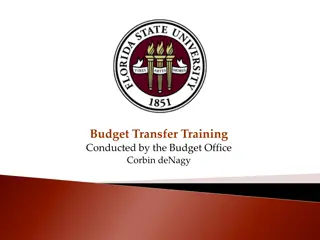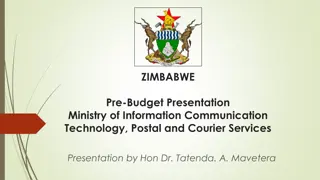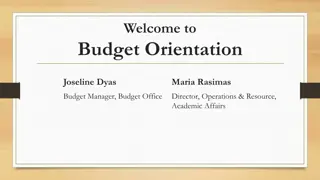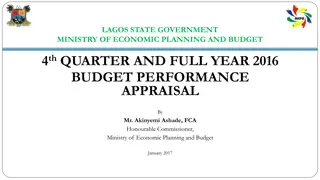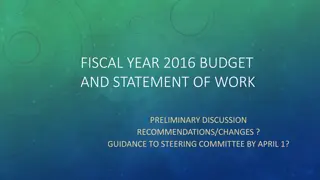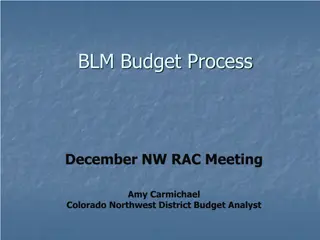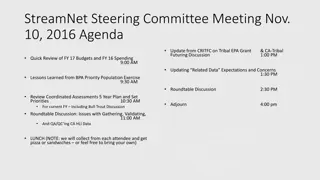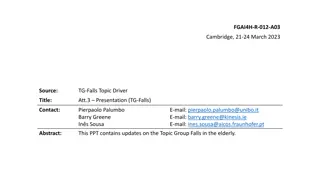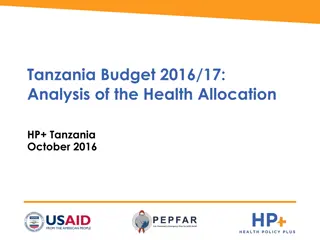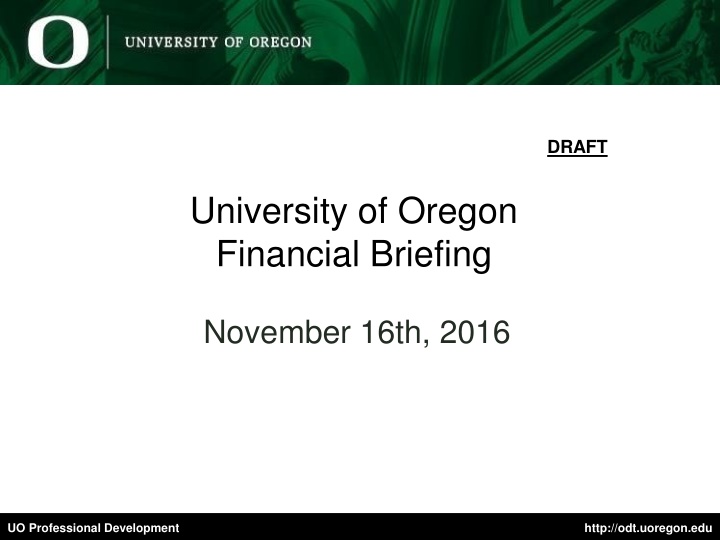
University of Oregon Financial Briefing Highlights 2016
Explore key insights from the University of Oregon's financial briefing in 2016, covering budget information, revenue streams, and the impact of decreased state appropriations on the institution. Gain valuable information on the university's budget structure, dependence on nonresident tuition, and major cost drivers projected for the future.
Download Presentation

Please find below an Image/Link to download the presentation.
The content on the website is provided AS IS for your information and personal use only. It may not be sold, licensed, or shared on other websites without obtaining consent from the author. If you encounter any issues during the download, it is possible that the publisher has removed the file from their server.
You are allowed to download the files provided on this website for personal or commercial use, subject to the condition that they are used lawfully. All files are the property of their respective owners.
The content on the website is provided AS IS for your information and personal use only. It may not be sold, licensed, or shared on other websites without obtaining consent from the author.
E N D
Presentation Transcript
DRAFT University of Oregon Financial Briefing November 16th, 2016 UO Professional Development http://odt.uoregon.edu
Agenda Background Budget Information Non-Resident Tuition Dependency FY15, FY16 and FY17 Budget Issues FY18 Projected Major Cost Drivers UO Professional Development http://odt.uoregon.edu
UO Budget Structure Other Funds E&G Funds Grants and Contracts revenue Auxiliary Revenue Service Center Revenue Designated Operations Revenue Restricted gifts Tuition revenue State Appropriation F&A Return Overhead revenue Fee revenue, interest earnings School & College Budgets Grants & Contracts Central Admin Budgets Plant Funds Institutional Expenses (Debt, assessments, utilities, leases) Auxiliary, Service Centers, and Designated Ops Funds Restricted Gifts UO Professional Development http://odt.uoregon.edu
Decreased levels of State Appropriation Loss of over $15 million of annual support per year $90 $80 $70 $60 $50 $40 $30 $20 $10 $- FY08 FY09 FY10 FY11 FY12 FY13 FY14 FY15 FY16 UO Professional Development http://odt.uoregon.edu
University Resources FY2016 Major Revenue Streams (E&G Fund) State Appropriation $64.8 million Resident Tuition $104.0 million Nonresident Tuition $281.1 million UO Professional Development http://odt.uoregon.edu
Increasing Dependence Upon Nonresident Tuition FY2004 Revenue Breakdown FY2016 Revenue Breakdown 14.4% 41.2% 30.0% 23.1% 62.5% 28.8% Nonresident Tuition as % of Total Three sources Resident Tuition as % of Total Three sources State Appropriation as % of Total Three sources Non-Resident Tuition as % of Total Three Sources Resident Tuition as % of Total Three Sources State Appropriation as % of Total Three Sources UO Professional Development http://odt.uoregon.edu
UO Budget Structure Other Funds E&G Funds Grants and Contracts revenue Auxiliary Revenue Service Center Revenue Designated Operations Revenue Restricted gifts Tuition revenue State Appropriation F&A Return Overhead revenue Fee revenue, interest earnings School & College Budgets Grants & Contracts Central Admin Budgets Plant Funds Institutional Expenses (Debt, assessments, utilities, leases) Auxiliary, Service Centers, and Designated Ops Funds Restricted Gifts UO Professional Development http://odt.uoregon.edu
Context E&G Fund E&G Fund - Characteristics 80% funded with tuition revenue Funds majority of activity in schools and colleges and administrative units Over 80% invested in people E&G Fund Recent History FY15: $10 million deficit ($6.5 million related to recurring issues) FY16: Balanced due to state investment and tuition increase FY17: Projections balanced due to tuition increase and cost containment efforts UO Professional Development http://odt.uoregon.edu
Summary Major E&G Fund Cost Drivers Cost Driver Original Estimates FY18 Cost Increases Revised Estimates FY18 Cost Increases Faculty and Staff Salary and Wages $10.6 million $11.0 million GTF Salary and Wages TBD $800K Medical Costs $2.2 million $1.6 million Retirement Costs $6 million $7.1 million Institutional Expenses $1.5 million $1.0 million Strategic Investments (includes $1 million for new faculty) $2.0 million $2.0 million IT Infrastructure Investments $2.75 million? TBD Increase to Minimum Wage TBD TBD Investments in Tenure Track Faculty $1.5 million $1.5 million Total Project Cost Increases* *Does not include, increases to minimum wage, costs related to federal FLSA regulations changes regarding eligibility for overtime pay; further investments in diversity initiatives, or individual school/college/department investments. $26.5 million* $25.0 million* UO Professional Development http://odt.uoregon.edu
FY18 E&G Fund Major Cost Drivers Factor Projected Cost Increase Notes Faculty and Staff Salary and Wages $11.0 million Per collective bargaining agreements. Officers of Administration salary package assumed to be similar to faculty salary package. Does not include GTF salary increases GTF Salary and Wages $800K Assumes insurance cost increases only 50% of last year Medical Cost (PEBB) $1.6 million Assumes average 3.4% increase (Dec. 2016 rate) for entire year UO Professional Development http://odt.uoregon.edu
FY18 E&G Fund Major Cost Drivers (continued) Factor Projected Cost Increase Notes Based on recently releasd updated PERS information. Assumes 400K of savings as Tier 1&2 employees retire and are replaced with Tier 3 & 4 employees. PERS Board projecting additional significant increases to occur in FY20 and FY22. Retirement Costs (PERS) $7.1 million Institutional Expenses $1.0 million Debt, rent, utilities, insurance and assessments. Strategic Investment Fund $1 million pre-committed to tenure track faculty hires as part of cluster hires. $2.0 million UO Professional Development http://odt.uoregon.edu
FY18 E&G Fund Major Cost Drivers (continued) Factor Projected Cost Increase Notes IT Infrastructure Investments TBD Necessary Phase One investments.. Increase to Minimum Wage New minimum wage law implemented. Mostly affecting student workers at this point. TBD Investments in New Tenure Track Faculty $1.5 million UO Professional Development http://odt.uoregon.edu
Summary Major E&G Fund Cost Drivers Cost Driver Revised Estimates FY18 Cost Increases Faculty and Staff Salary and Wages $11.0 million GTF Salary and Wages $800K Medical Costs $1.6 million Retirement Costs $7.1 million Institutional Expenses $1.0 million Strategic Investments (includes $1 million for new faculty) $2.0 million IT Infrastructure Investments TBD Increase to Minimum Wage TBD Investments in Tenure Track Faculty $1.5 million Total Project Cost Increases* *Does not include, increases to minimum wage, costs related to federal FLSA regulations changes regarding eligibility for overtime pay; further investments in diversity initiatives, or individual school/college/department investments. $25.0 million* UO Professional Development http://odt.uoregon.edu
Current Service Level Analysis Sample Figures Only for Easy Math FY16 / FY17 - $100 million FY18 / FY19 - $103 million FY2016 $49 M FY2017 $51M FY2018 $50.5M -1.0% FY2019 $52.5M 4.0% 3.0% CSL FY16 / FY17 - $100 million FY18 / FY19 - $108 million FY2017 $51M FY2016 $49 M 7.9% CSL FY2018 $52.9 3.8% FY2019 $55.1M 4.2% UO Professional Development http://odt.uoregon.edu






